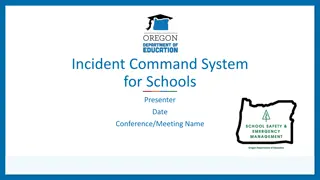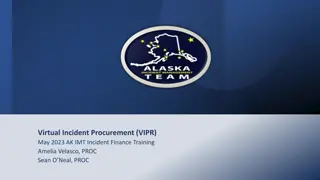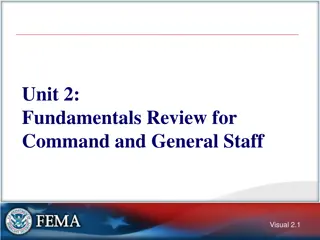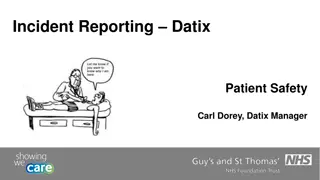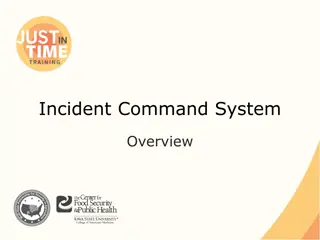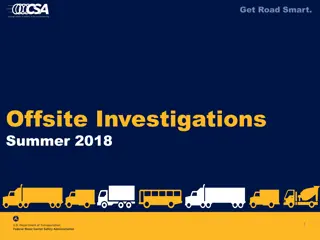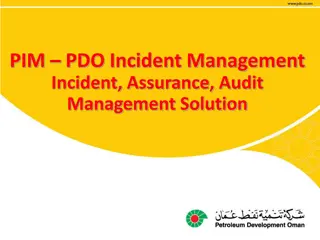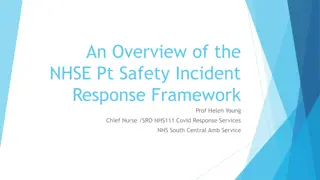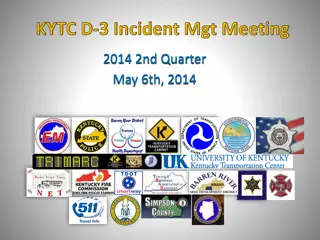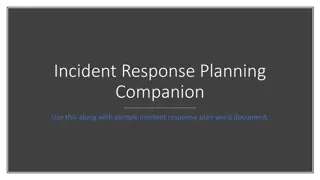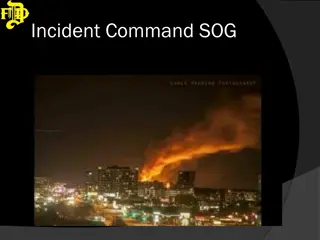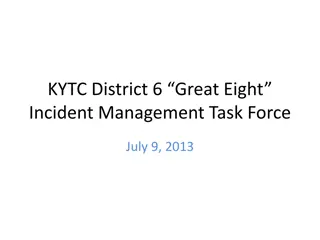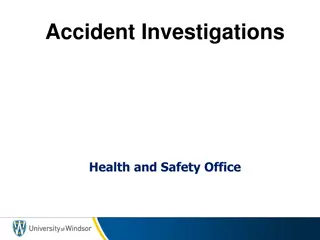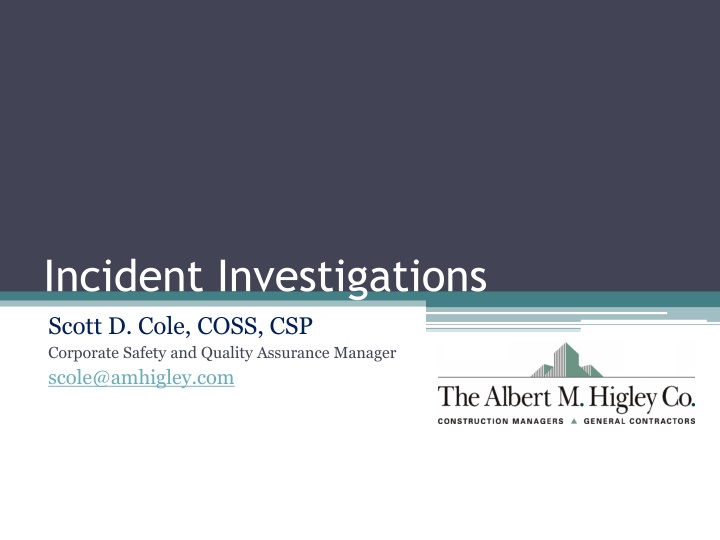
Incident Investigations and Safety Guidelines
Explore the importance of incident investigations, safety guidelines, and accident prevention techniques. Understand the key factors contributing to incidents and how to effectively investigate and prevent them. Learn about supervisors', safety professionals', and safety committees' roles in ensuring workplace safety.
Download Presentation

Please find below an Image/Link to download the presentation.
The content on the website is provided AS IS for your information and personal use only. It may not be sold, licensed, or shared on other websites without obtaining consent from the author. If you encounter any issues during the download, it is possible that the publisher has removed the file from their server.
You are allowed to download the files provided on this website for personal or commercial use, subject to the condition that they are used lawfully. All files are the property of their respective owners.
The content on the website is provided AS IS for your information and personal use only. It may not be sold, licensed, or shared on other websites without obtaining consent from the author.
E N D
Presentation Transcript
Incident Investigations Scott D. Cole, COSS, CSP Corporate Safety and Quality Assurance Manager scole@amhigley.com
The A Word Accident versus Incident
Why Do We Investigate? Determine why the failure(s) occurred Fact finding, NOT fault finding
10 Axioms of Industrial Safety -H.W. Heinrich 1. Injuries result from a series of preceding factors. 2. Accidents occur as the result of a physical hazard or an unsafe act. 3. Most accidents are the result of unsafe behavior. 4. Unsafe acts and hazards do not always result in immediate accidents and injuries. 5. Understanding why people commit unsafe acts helps to establish guidelines for corrective actions.
6. The severity of the injury is largely fortuitous and the accident that caused it is preventable. 7. The best accident prevention techniques are analogous to best quality / productivity techniques. 8. Management should assume safety responsibilities. 9. The supervisor is the key person in the prevention of industrial accidents. 10. Cost of accidents include both direct costs and indirect costs.
Heinrich Continued The Origins of Accidents 88% - unsafe acts of persons 10% - unsafe physical conditions 2% - AOG Domino Theory
Multicausal Theory Two contributing factors of all incidents: Immediate Directly associated with the incident Basic Deficiencies associated with the management system
Coles Law Always thinly slice cabbage
When Do We Investigate? The key difference in an incident which results in an injury and one that doesn t is often luck! Investigate every incident, no matter how small
Who Should Investigate? Supervisor Safety Professional Safety Committee (peer investigation) Training, training, training
8 Steps to a Thorough Investigation 1. Prepare for the Investigation 5. Write a Report 6. Recommend Corrective Actions 2. Gather the Facts 3. Analyze the Facts 7. Correct the Situation 4. Develop Conclusions 8. Follow-Up on Recommendations
Prepare for the Investigation 1. Establish a notification system 2. Identify / establish emergency services 3. Establish emergency shutdown procedures 4. Training 1. How to conduct an investigation 2. Identifying immediate and basic causes 3. Documentation 5. Written program and report form 6. Incident investigation toolbox
Gather the Facts Immediately Identify and interview witnesses View the area Take photographs, create drawings Collect evidence Noise levels, weather conditions, light conditions, etc. Gather documentation
Analyze the Facts Be sure the information accurate
Develop Conclusions What happened? How did it happen? Why did it happen? All conclusions must be made on fact, not speculation
Conclusions Continued Immediate Causes PPE Safe Work Practices Guarding Housekeeping Equipment Failure
Conclusions Continued Basic Causes Knowledge and/or Training Supervision Engineering Practices PPE Maintenance Programs Equipment Selection Feedback Systems Practices and/or Procedures
Write a Report Standardized report Everything must be supported by fact and evidence Clear, concise, free from extraneous information Include photographs, drawings, witness statements, etc.
Recommend Corrective Actions All basic causes must have corrective actions Management needs to assign a person responsible and establish a measurable timeframe (deadline) for completion Correct the Situation
Follow-Up on Recommendations Safety Action Items Target Completion Date: Actual Completion Date: Responsible Employee: AI #: Priority: Safety Action Item: A=Emergency - Will Cause A Loss If Not Corrected B=Needs Corrected Immediately But Not An Emergency C=Cannot Cause Damage Or Injury But Still Needs Corrected
Step 9 - Bonus Round! Incident Analysis and Data Collection Five-Year Injury Analysis 7 6 5 2006 2007 4 2008 3 2009 2010 2 5-Year Trend 1 0
Types of Injuries 5% 10% 10% 40% Contact With or Against Overexertion CTD Slips/Trips/Falls Other 35%
Injuries - Body Part 5% 19% 14% Back Ankle 5% 5% Arm Eye 5% 5% Finger Hand 5% 10% Head Hip 9% Knee 9% Leg 9% Shoulder Whole Body - Illness
Questions? Thank you for your attention.


